 While curating the collection of American Revolution newspapers featured in Reporting the Revolutionary War, I stumbled upon a rare 18th century American newspaper loaded with mystery and intrigue. Most newspapers of the era are well documented and catalogued by academic research institutions, but this one seemed to have slipped through the cracks for more than two centuries. Despite printing content of great historical importance, I found the issue wasn’t mentioned by any authority on Revolutionary newspapers and apparently never cited in history texts. The newspaper is a postscript edition of the Pennsylvania Journal dated April 27, 1775 (No. 1690), publishing extracts of three letters from Boston written just hours after the Battle of Lexington and Concord. The full transcripts of all three letters, containing eyewitness accounts of the Revolutionary War’s first full battle, can be found in Peter Force’s American Archives (Letter 1|Letter 2|Letter 3).
While curating the collection of American Revolution newspapers featured in Reporting the Revolutionary War, I stumbled upon a rare 18th century American newspaper loaded with mystery and intrigue. Most newspapers of the era are well documented and catalogued by academic research institutions, but this one seemed to have slipped through the cracks for more than two centuries. Despite printing content of great historical importance, I found the issue wasn’t mentioned by any authority on Revolutionary newspapers and apparently never cited in history texts. The newspaper is a postscript edition of the Pennsylvania Journal dated April 27, 1775 (No. 1690), publishing extracts of three letters from Boston written just hours after the Battle of Lexington and Concord. The full transcripts of all three letters, containing eyewitness accounts of the Revolutionary War’s first full battle, can be found in Peter Force’s American Archives (Letter 1|Letter 2|Letter 3).
The first letter from Boston to a gentleman in New York, dated April 19, explains that the action “alarmed the country so, that it seemed as if men came down from the clouds.”
The second letter to a gentleman near Philadelphia, dated Boston, April 20, called the scene “the most shocking that New-England ever beheld… I stood upon the hills in Town and saw the engagement very plain, which was very bloody for seven hours… communication between town and country is at present broke off; they were till ten last night bringing over their wounded, several of whom are since dead, two officers in particular. When I reflect, and consider that the fight between those whose parents but a few years ago were brothers, I shudder at the thought, and there is no knowing where our calamities will end.”
Multiple sources point to Boston merchant John Andrews as the author of the second letter.
The three letters likely reached Philadelphia on April 25 or 26, a day or two after the arrival of Joseph Palmer’s Lexington Alarm. NewsBank’s Historical Newspaper Archive shows the three letter extracts were also printed in subsequent Philadelphia and Williamsburg newspapers, but none before April 27.
According to J. L. Bell of Boston 1775, we know these three letters did not travel along with Joseph Palmer’s Lexington Alarm letter because that left Watertown by 10:00 a.m. on April 19. The first of the letters printed in the postscript describes events through 7:00 p.m. on that day, and probably took a couple more hours to complete. And the others are dated April 20 so they probably started their journey a day after Palmer’s note. How the originals got out of Boston is an interesting question. The post riders didn’t have a monopoly on the mails; the writer(s) may have sent these letters out on ships, either all the way to the other harbors or put in the post somewhere along the way. Alternatively, some people or documents might have been let through the siege lines early on.
The single-sheet postscript edition of the Pennsylvania Journal containing these three letters was published by William and Thomas Bradford, and discovered in 2010 among the possessions of an antique dealer who had been deceased 10 years. The dealer’s next of kin claimed that the newspaper sat framed and untouched for at least 25 years. After winning the newspaper at auction, taking possession and carefully removing it from its frame, I was able to determine that the issue, measuring approximately 8.25″ (w) x 10.25” (h), was indeed single sided with a clear imprint of period type protruding on the verso. Holding the paper up to the light and looking through it I could see the chain and laid lines of the mold used when handmaking the paper. The textured linen fibers still had a fluffy bounce to them suggesting the broadside issue was not previously bound into a volume. It was one of the most beautifully preserved specimens of 18th century newspapers I had ever come across, but was it genuine and had it really been lost to the world for 200+ years?
Having handled thousands of historic prints dating as far back as the 15th and 16th centuries I had my own discerning eye, but the quality of this particular newspaper was so remarkable that I also sought the opinions of three third-party authorities. The verdict was quick and unanimous – authentic.
In 1775, the average circulation of 38 American newspapers being printed was 600 and very few of those originals exist today. The two popular indices of 18th century newspapers – Clarence S. Brigham’s History and Bibliography of American Newspapers, 1690-1820, and the Library of Congress’s Chronicling America – identify institutional holdings of these papers and often expose extreme scarcity of original issues printed before 1780. So after researching the document’s contents and confirming its authenticity with trusted sources I contacted more than a dozen institutions, known for their pre-1776 and early Philadelphia newspaper holdings, to inquire more about the specific issue. I received responses from these 10 institutions:
- Library of Congress
- American Antiquarian Society
- Historical Society of Pennsylvania
- Library Company of Philadelphia
- State Library of Pennsylvania
- Moravian Archives – Bethlehem
- New York Public Library
- Wisconsin Historical Society
- Beinecke Rare Book & Manuscript Library – Yale University
- William L. Clements Library – University of Michigan
None of the institutions could produce any evidence of the April 27 postscript to the Pennsylvania Journal ever existing – it wasn’t available in facsimile, in microfilm or as an original issue (loose or bound into a volume). As far as I could tell, this was something lost and forgotten to both the general public and academia. It was my 18th century newspaper equivalent of a great archaeological discovery. And I knew this may well be the only copy that survives today.
Extra, supplement or postscript editions of newspapers like this sheet were irregular and only offered when the printer had a surplus of news or advertisements to circulate. So unlike standard newspaper issues, postscripts can be tricky when determining what was printed. For example, the American Antiquarian Society (AAS), home of the largest collection of pre-1877 printed material, shared with me a story about an unrecorded extra edition of a newspaper printed in 1820 that it once acquired. The AAS happened to hold the publisher’s file for this newspaper title and discovered that the extra it had just acquired at auction didn’t even exist in the publisher’s own record. In 1820, more newspaper printers were boasting larger circulations and publishing more frequently, so it is perhaps understandable that an extra issue was overlooked then. In 1775, however, William and Thomas Bradford published 52 weekly issues of the Pennsylvania Journal – all on Wednesdays. The AAS, which is assumed to be one of the most comprehensive archives of the title, also holds four supplement, postscript or extra issues printed on other days of the week that year, but nothing on April 27.
This rare, seemingly one-of-a-kind, postscript edition of the Pennsylvania Journal is no longer lost to the world. After my exciting discovery process that revealed the paper’s contents and scarcity, it now sits in the archives of the nation’s oldest federal cultural institution – the Library of Congress – where it is finally in the public record and available to scholars. And here, for the first time on public display, readers of the Journal of the American Revolution can study and appreciate it (see pictures below). Enjoy!




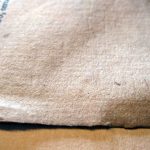

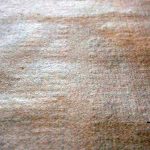

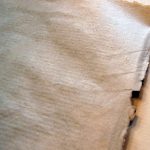

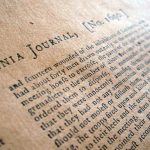
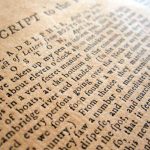
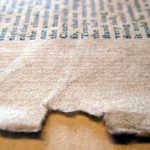
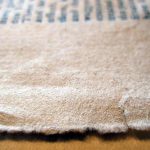
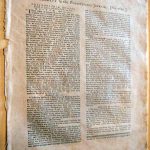





10 Comments
This is exciting reading! Besides finding this one-of-a-kind issue your discovery also opens the door that there might be other newspapers (or letters, diaries, etc.) waiting to be found. It puts to rest the old adage “there is nothing new under the sun.” Many people seem to think that “history” has all be discovered/recorded. Your find clearly illustrates that we, all of us, must keep our eyes open to not only new ways of looking at old material but for old material that has slipped through the cracks. It seems very likely that the antique dealer didn’t know what he had – to him it may have been just a very nicely preserved old newspaper….while in fact it was a treasure hiden in plain sight.
Definitely. The greatest newspaper discovery yet to be made is a copy of Benjamin Harris’s Publick Occurrences (Boston) from 1690. Only one original known to exist. It would have been the first American newspaper if it had survived beyond its first issue. Now the title of first successful newspaper goes to the Boston News-Letter, which started 14 years after Harris’s attempt.
I would hazard a guess that your heart rate went up as you examined the paper for the first time as you wondered whether or not you had made a major historical discovery in your field. This also shows that once again, history is still being rediscovered all the time. Who knows what lurks in the closets and attics across America?
I believe this is an example of how a History Harvest could reveal more historical artifacts people have in their possession.
Exactly. And that is why I love the show American Pickers so much! 🙂
Bravo on a great find and article. Ever since the “shot heard ’round the world” was fired I wondered who fired. Your experience encourages that thought. Somewhere, somehow there may be a revealing eyewitness account that discloses this great historical riddle. I love this website for its continuing contributions to the study of the American Revolution in highly readable, informative and entertaining subject matter. As a book collector I hope to see a collection of this and other pieces nicely bound. I also hope you take the tax deduction for your donation to the Library of Congress to help support your next book.
Thanks, Steven. I appreciate the compliments and your loyal readership here at allthingsliberty.com. While I’ve donated many newspapers, this particular paper wasn’t donated to the Library of Congress — they bought it. I had to recover some of my investment.
I actually hoped you did sell it (I would have) so the story has a really happy ending. I still can’t get over how clear the type looks.
Awesome, Todd. The second letter is indeed from John Andrews to William Barrell — see John Andrews, “Letters of John Andrews of Boston, 1772-1776,” MHS, Proceedings, 8 (1864-1865), 403-405. There seem to be a few minor differences in transcription — you might want to check these out.
I wasn’t aware of these American Archives selections online. A great resource difficult to find in print. Note that many of Pauline Maier’s 90 “other” declaration of independence appear on the American Archives collection.
Good stuff, Ray. Thanks for the tip!
What a wonderful find. These are the discoveries that reward the obsessed collector for all of their hard work (I know, I’m one). But a note about ” I could see the chain and laid lines of the mold used when handmaking the paper.” I’ve heard appraisers on Antiques Roadshow state that the chain and laid lines prove that it is genuine antique laid paper. About 25 years ago I was at a flea market in Maine and a seller had a stack of gun broadsides from two gunmakers. He wanted $5 each. They were circa 1840’s. I wasn’t sure if they were real or not. They sure looked real. I held one up to the sky and I could see the chain and laid lines and a watermark. The exposed edges of the irregular stack of these broadsides had dark and dusty areas where those edges, often a quarter of an inch of paper, was exposed. They sure looked real. They looked like they had been sitting in this stack for over 100 years. I asked the seller if they were real and old. He said he didn’t know. I only bought two of them. That’s how much confidence I had in great flea market finds. Many years later I purchased the book “Ornithology Books in the Library of Trinity College, Hartford” published in 1983. When I got the book I took the jacket off and started to put it into a mylar protector. I noticed chain and laid lines, in a 1983 dust jacket! I held it up to the light and saw the watermark TWEEDWEAVE. I looked at those two gun broadsides and sure enough the watermark was TWEEDWEAVE. All I can find on the web about tweedweave paper is that it apparently dates back to at least 1910. Some years later I saw one of those gun broadsides at a Portland Oregon antiques show for $300. Was it real? I don’t think so. I’m sure your newspaper is real, but one always needs to be careful with old paper. Rather then looking for chain and laid lines, look for the type impressions (pushed into the paper) on the back side. It looks like someone else came across one of these broadsides:
http://archiver.rootsweb.ancestry.com/th/read/PAPER-MILLS-MAKERS/2001-02/0981647382